 For a profile of Nike Okundaye, click here For a profile of Nike Okundaye, click here
Lagos
 As soon as you claim your
luggage and clear customs, Nike’s staff take you to her home on the
Lekki Penninsula. There, you can browse the art gallery featuring the
whole panoply of Nigerian arts, or see some of the documentaries that
have been made about Nigerian culture. While in Lagos, you might want
to see the spectacular collection of traditional sculptures and carving
in the National Museum, or visit the National Gallery to acquaint
yourself with some of the country’s modern masters. Visit bookstores to
buy Nigerian novels or histories or special works on cultural topics
(the country has an active publishing industry). As soon as you claim your
luggage and clear customs, Nike’s staff take you to her home on the
Lekki Penninsula. There, you can browse the art gallery featuring the
whole panoply of Nigerian arts, or see some of the documentaries that
have been made about Nigerian culture. While in Lagos, you might want
to see the spectacular collection of traditional sculptures and carving
in the National Museum, or visit the National Gallery to acquaint
yourself with some of the country’s modern masters. Visit bookstores to
buy Nigerian novels or histories or special works on cultural topics
(the country has an active publishing industry).
You’ll
discover a city far more welcoming than the ferocious Lagos of modern
myth. It’s a Third World megalopolis, all right, and even Nike’s
authority can’t make traffic jams disappear or the electrical system
function. No one would ever use words like “pleasant” or “relaxing” in
reference to the commercial capital of West Africa, but Lagos is a
lively, chaotic, fast-moving city. Your Lagos stay can be as long or as
brief as you like. Don’t be surprised, though, if you leave Nigeria
with a certain fondness and respect for Lagos.
Oshogbo
 In
the 1950s, in this small city in the cocoa producing area of Nigeria, a
couple of German artists took up residence, and soon gathered about
them a troop of traditional craftsmen and artists. The result was a
synthesis between Yoruba tradition and the modern world; the Oshogbo
School heralded the birth of contemporary African art. In
the 1950s, in this small city in the cocoa producing area of Nigeria, a
couple of German artists took up residence, and soon gathered about
them a troop of traditional craftsmen and artists. The result was a
synthesis between Yoruba tradition and the modern world; the Oshogbo
School heralded the birth of contemporary African art.
Oshogbo
has grown, and is now the capital of the newly created Osun State. Its
arts and crafts still flourish alongside the modern conveniences of
internet cafes and supermarkets. You’ll stay in the neo-traditional
palace that is Nike’s Oshogbo home. Visit artists the workshops and
galleries of internationally known figures such as Jimoh Buraimoh,
Jacob Afolabi, or Chief Oloruntoba. Apprentice yourself to a cloth
dyer, or drummer, or sculptor. Enjoy traditional dances and music in
the evening. Wander through the narrow, winding streets of the old
city. Explore a traditional market. Visit the Sacred Grove of Osun, the
river goddess. You may wish to schedule your visit to coincide with the
spectacular Osun Festival in August, when Oshogbo explodes in colorful
masquerades.
Ogidi
 Have
you ever wondered what life is like in an African village? Ogidi,
Nike’s home town nestled among the spectacular rock out croppings of
Kogi State, has a population of about 3000. Climb these hills to get a
panorama of rain forest farms and towns. You observe the process of
Yoruba textile production, from the cotton grown on small farms in
Ogidi through the spinners, weavers and dyers in the women’s
cooperative that Nike developed. In the evenings the local dance troop
entertains you with traditional music and dance, or maybe you’ll be
treated to a few scenes from the traveling theater that was a feature
of Yoruba life in the 40s and 50s. Chat with local residents, as they
practice their English and teach you their own language. Ask the elders
to recount the history of their village to you. Visit the remains of
the British garrison that was stationed there in the late 19th century,
or explore the ruins of the village on a nearby mountain where Ogidi
was originally sited. Have
you ever wondered what life is like in an African village? Ogidi,
Nike’s home town nestled among the spectacular rock out croppings of
Kogi State, has a population of about 3000. Climb these hills to get a
panorama of rain forest farms and towns. You observe the process of
Yoruba textile production, from the cotton grown on small farms in
Ogidi through the spinners, weavers and dyers in the women’s
cooperative that Nike developed. In the evenings the local dance troop
entertains you with traditional music and dance, or maybe you’ll be
treated to a few scenes from the traveling theater that was a feature
of Yoruba life in the 40s and 50s. Chat with local residents, as they
practice their English and teach you their own language. Ask the elders
to recount the history of their village to you. Visit the remains of
the British garrison that was stationed there in the late 19th century,
or explore the ruins of the village on a nearby mountain where Ogidi
was originally sited.
You
might want to take a day to visit Lokoja, located 45 miles away at the
confluence of the Niger and Benue Rivers. Now a busy market town and
the capital of Kogi State, Lokoja was the site of the first capital of
Nigeria when the British amalgamated the colony of Lagos, the Oil
Rivers Protectorate, and the Northern Territories. It was in Lokoja,
while gazing out at the river that stretched before her, that Lord
Lugard’s mistress coined the name “Nigeria.” The explorer Mungo Park is
buried in Lokoja, as is Lord Lugard.
Abuja
Nigeria’s
new capital is an attractive modern city set in the middle of the
country. It is too new to have developed a flavor or personality of its
own; it offers none of the excitement of Lagos, but it also frees you
from the traffic problems that plague the commercial capital. You may
choose to arrive in Nigeria at the small and quiet international
airport at Abuja. The Abuja center is Nike’s newest.
|

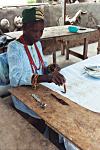

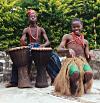
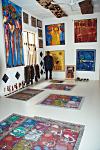
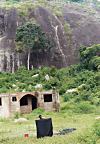
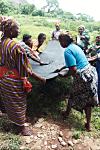







![]()